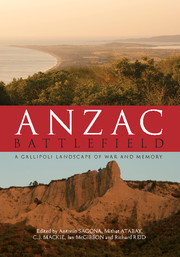Book contents
- Frontmatter
- Foreword
- Contents
- Figures
- Plates
- Contributors
- Acknowledgements
- Abbreviations
- Gallipoli battlefield place names
- Introduction
- 1 Boundary and divide: The antiquity of the Dardanelles
- 2 The Gallipoli campaign: History and legend
- 3 Recording the battlefield: First steps
- 4 Capturing the battlefield: Mapping and air photography at Gallipoli
- 5 Battlefield archaeology: Gallipoli
- 6 Forming the ANZAC battlefield
- 7 Forming the Ottoman battlefield
- 8 Artefacts from the battlefield
- 9 Remembering Gallipoli
- 10 Remembering Gallipoli from a Turkish perspective
- Conclusion
- Appendix Anzac Gallipoli Archaeological Database
- References
- Index
6 - Forming the ANZAC battlefield
Published online by Cambridge University Press: 05 December 2015
- Frontmatter
- Foreword
- Contents
- Figures
- Plates
- Contributors
- Acknowledgements
- Abbreviations
- Gallipoli battlefield place names
- Introduction
- 1 Boundary and divide: The antiquity of the Dardanelles
- 2 The Gallipoli campaign: History and legend
- 3 Recording the battlefield: First steps
- 4 Capturing the battlefield: Mapping and air photography at Gallipoli
- 5 Battlefield archaeology: Gallipoli
- 6 Forming the ANZAC battlefield
- 7 Forming the Ottoman battlefield
- 8 Artefacts from the battlefield
- 9 Remembering Gallipoli
- 10 Remembering Gallipoli from a Turkish perspective
- Conclusion
- Appendix Anzac Gallipoli Archaeological Database
- References
- Index
Summary
By the end of the first day of the landing the Anzacs held a tenuous defensive perimeter, encompassing just 6km2. On the edge of what was ‘only a cheese-bite out of the cliffs’, according to New Zealand and Australian Division commander Sir Alexander Godley, the invaders had clung on to intermittent positions as Ottoman pressure forced them back during the afternoon of the 25th. If the events of that day set the limits of the ‘Old Anzac’ battlefield – as compared with the larger area held after the August offensive – the unrelenting efforts of men on both sides of the line would shape it in the next two months. In the prevailing siege-like conditions, most of the garrison contributed to the process of forming the battlefield. But one group in particular – the Australian and New Zealand field engineers – played a key role, providing the direction of much infantry effort and often the labour needed to create the essential defences and facilities.
The focus of this chapter will be less on the course of the fighting at Anzac than on the setting of the struggle: the landscape of siege warfare in this particular section of the Gallipoli battlefield. Although the battles fought here have been described and analysed in great detail, both in the official histories published by Australia and New Zealand shortly after the end of the First World War and in numerous more recent works, less attention has been given to the physical context of the struggle. The sappers’ efforts in creating the trench and tunnel defence systems that made possible prolonged resistance to the Ottomans in such unpropitious circumstances, although never entirely ignored, have generally been relegated to the back stage. In this context it has also been all but forgotten that the ordinary infantryman in the AIF or NZEF spent far more of his time at Anzac digging and improving the trench system than he did in fighting the enemy.
The Old Anzac battlefield began, at its southern extremity, at positions on the ridge immediately above the beach. Stretching north from Chatham's Post for nearly 2.5km, it followed the edge of a spur of the dominating Sari Bair Range.
- Type
- Chapter
- Information
- Anzac BattlefieldA Gallipoli Landscape of War and Memory, pp. 98 - 137Publisher: Cambridge University PressPrint publication year: 2016



